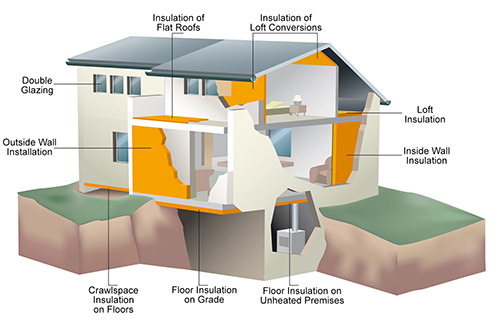Insulation
An un-insulated home loses a quarter of its heat through the roof. By insulating your loft, attic or flat roof you can reduce heat loss and reduce your heating bills.
Cavity Wall Insulation
A cavity wall is made up of 2 layers with a small gap between them; as there are 2 layers it is more difficult for heat to pass through. Therefore your home retains the heat more efficiently.

Flat Roofs
The roof is insulated by adding a layer of rigid insulation board on top of the roof’s weatherproof layer or directly on top of the timber roof surface with a new weatherproof layer on top of the insulation. There are 2 ways to insulate a flat roof:
- From above (the best method).
- From below (can cause condensation problems if done incorrectly).
Solid Wall Insulation
Solid walls are a layer of brickwork that lets through twice as much heat as cavity walls.
- Internal wall insulation: rigid insulation board is fitted to all of the walls, or a false wall is built and filled with mineral wool fibre insulation.
- External wall insulation: A layer of insulation material is fixed to the wall, then decorated with a special type of plasterwork.
Floor Insulation
Insulating your ground floor will save you up to £55 a year. There are 3 methods of insulation:
- Suspended Timber Floors: insulated by lifting up the floorboards and laying mineral wool insulation.
- Solid Floors: insulated using rigid insulation foam fitted either above or below the concrete.
- Rigid insulation can be laid on top of the original floor, then chipboard flooring can be placed over it.
Loft Insulation
Loft insulation is effective for at least 40 years and would be a cost effective investment as a homeowner.
For lofts of limited access a qualified professional can install blown insulation made from a fire retardant cellulose fibre or mineral wool.

Planning Permission
As changes are mainly internal for most insulation, planning permission is not normally required. If your building is listed, we recommend you consult with your local authority to ensure your insulation complies with building regulations.
Maintenance
No maintenance is required.

